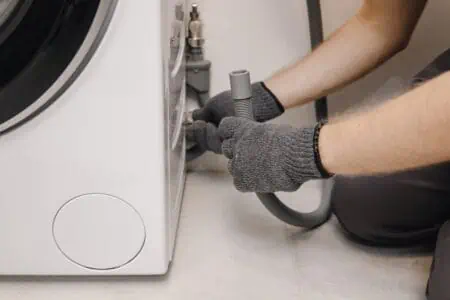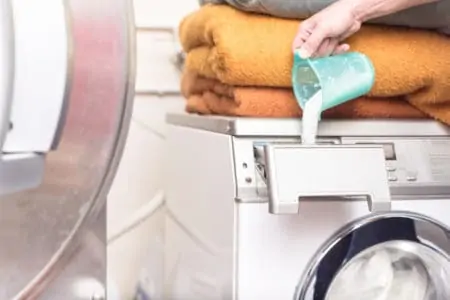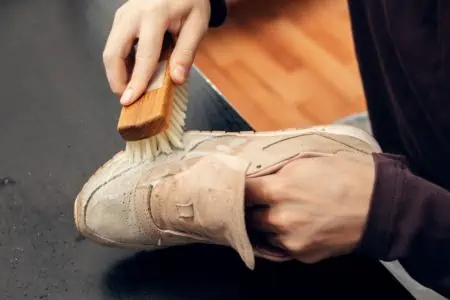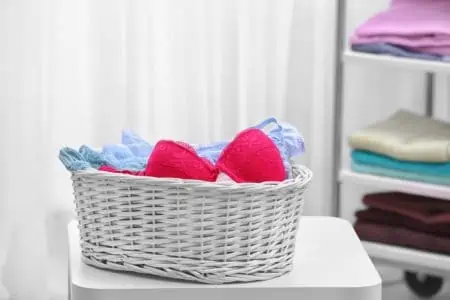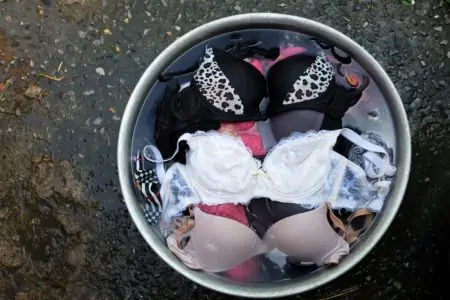Once you’ve established that the bad smell in the laundry room is coming from the washing machine drain, you can get started fixing it.
Before you call a plumber, we’ll show you how to get rid of smells from a laundry drain by yourself. These methods use products you likely already have in the house and can save you hundreds of dollars.
Keep reading to learn how to blast these stinky odors away — with or without bleach.
Key Takeaways
- Laundry drain smells can be caused by sewer gas, mold, mildew, cracked pipes, or a dirty washing machine.
- Remove laundry drain odors using boiling water, baking soda and vinegar, bleach, or mineral oil.
- To prevent laundry drain smells, use the machine regularly, clean it often, and use high-quality detergent.
- Be cautious when dealing with rotten egg scents; call a professional if you suspect sewer gas issues.
Why Does My Laundry Drain Smell Like Rotten Eggs?
If there’s a rotten egg smell coming from the laundry drain, here’s what could be causing it:
- Sewer gas: Sewer gas might be working its way back into your machine. This is usually because the drain or sewage line is blocked by a clog or the drain hose itself. It’s best to contact a professional if you suspect sewer gas.
- Mold or mildew: Mold, mildew, and bacteria can cause rotten egg odors. You will need to deep clean the machine and the drain line, then implement regular maintenance.
- Cracked drain pipe: A cracked or leaking pipe can release septic gasses, causing awful odors.
- A dirty machine: Sometimes, it’s as simple as the machine being dirty. Deep clean the machine, the door seal, and the gasket. This alone can remove unwanted smells.
If you suspect sewer gas, call a professional. This gas can often lead to unpleasant symptoms like headaches, dizziness, or nausea (1).
While you can use our methods below to try and counteract a rotten egg odor, our instructions are for more general odors. You should always be cautious when dealing with a rotten egg scent yourself.
Hazard
If you notice a gas smell, turn the machine off, leave the house immediately, and call your gas company or 911.
How To Get Rid of Smell From Laundry Drain
Removing odors from your laundry drain isn’t too challenging. You can use non-toxic products like baking soda and vinegar. Or you can go full strength with bleach or mineral oil.
These methods work for high-efficiency washers, top-load washing machines, and front-load washing machines.
Are you ready to tackle these foul odors? Let’s get into our five expert-recommended methods.
With Boiling Water
Boiling water holds powers that can often flush away odor-causing gunk. To use, follow these instructions:
- Boil water: Boil water on the stove or in a kettle.
- Pour: Pour half a pot of boiling water down the drain.
- Wait: Give it a few minutes to work its magic. When it runs through the pipes, it will loosen any gunk or residue.
- Pour: Now pour cold water down the drain to rinse away the loosened debris.
- Pour again: Pour the rest of the boiling water down the drain.
If this method doesn’t deal with the odors, move on to another method.
With Baking Soda and Vinegar
The power of baking soda and vinegar can unclog drains, removing odors and residue.
- Heat vinegar: Heat four cups of distilled white vinegar on the stove.
- Pour baking soda: Pour one cup of baking soda down the drain.
- Pour vinegar: Pour two cups of the heated vinegar down the drain and cover the drain with a stopper. The baking soda and vinegar will fizz up, so it might overflow if you don’t use a stopper.
- Wait: Leave the mixture in the drain for a couple of minutes. You can leave it overnight if you suspect a clog.
- Pour vinegar: Pour the rest of the hot vinegar down the drain (you will need to reheat it if you leave it overnight).
- Pour hot water (optional): If you suspect a clog, you’ll need to flush it away. Boil two cups of water and pour it down the drain.
Another option for using baking soda and vinegar is to add one cup of baking soda and ½ cup of distilled white vinegar to your washing machine drum. Then run a hot cycle. The baking soda and vinegar will eventually run through the drain, killing odors and clearing clogs.
This method is better for preventative measures, but it might work to clear some bad odors coming from the drain.
With Bleach
Moving onto more powerful methods for how to eliminate laundry drain odor: bleach. Bleach is a great disinfectant, so if you suspect mold, mildew, or bacteria is causing the stench — try this.
- Choose a cycle: Select a hot cycle with an extra rinse. If your washing machine has a self-cleaning cycle, choose that.
- Add bleach: Add bleach to the bleach dispenser drawer, filling it to the maximum line.
- Start: Start the cycle and let it run all the way.
- Extra cycle: Run an extra cycle using hot water and an extra rinse. This is to remove all bleach residue.
Warning
Don’t pour bleach directly into your washing machine drain. This can react with other chemicals and cleaners lingering in the drain, which can create toxic gasses.
With Mineral Oil
Plumbers recommend this tip for dealing with sewer gas smells. This method won’t work for drain-clog-related odors, but if you are dealing with that rotten egg scent — this is worth a go.
- Pour boiling water: Pour about a gallon of boiling water down the washing machine drain.
- Add mineral oil: Pour four ounces of mineral oil down afterward to slow evaporation within the pipes. This prevents the sewer gasses from getting back into your home.
Check the P-Trap and Vent Pipe
Finally, check the P-trap and the vent pipe if the odors persist.
The P-trap is the curved section of pipe behind or near the washing machine. The u-shape creates a gravity barrier to prevent foul odors and gasses from re-entering your home. This should contain water to trap the odors.
But if the P-trap is empty, the seal is broken, and the odors will enter the house. This commonly happens if you don’t use your washing machine often. To add water to the P-trap, run a short cycle on the washing machine. When it drains, the water will run through the P-trap; some should stay inside, preventing odors.
However, sometimes the problem is a leak. In this case, you will need to replace the P-trap.
Cleaning the P-Trap
In other instances, the P-trap might contain a clog or residue. In that case, you will need to clean it. Here’s how:
- Turn off the machine: Turn off the machine and other sources of water that use the same drain (such as the kitchen sink).
- Place a bucket: Place a bucket under the P-trap to catch any residue.
- Remove the P-trap: Holding the connecting pipe, unscrew the nut holding the P-trap in position. Do the same on the other side and remove the P-trap. You might need to dislodge the P-trap using pliers or a wrench, especially if it’s been a while since someone last removed it. Water will start spilling out, so make sure your bucket is well-positioned.
- Remove clogs: Look in the P-trap and check for clogs. Use a damp flexible wire brush to push clogs out of the pipe. Continue to do this until there is no debris on the brush.
- Replace: Once you have removed the clog, replace the P-trap.
- Run water: Test the pipes by running water from the sink or running a short cycle on the washing machine. Check for odors. If they continue, move on to the next method. And if they continue after that, you’ll need to call a plumber.
Cleaning the Vent Pipe
The next reason for odors could be a clogged vent pipe. The vent pipe is usually located on your home’s roof or the side of the house near the 2nd floor. If the vent pipe is clogged, the sewer gasses are redirected back into the home.
You will need to access your roof to do this method. Call a professional if you’re not comfortable or experienced in safely accessing your roof. If you’re confident in your own safety, here’s how to clean the vent pipe:
- Use a plumbing snake: Put a plumbing snake down the top of the vent until it stops. That suggests there is a clog. Turn the handle on the snake to catch the clog. Once the plumber snake line starts to twist or kink, pull the snake back up to remove the object.
- Repeat: Run water down the drain to ensure it’s operating properly. If not, repeat the first step until the laundry machine drains correctly, and the odors are gone.
Top Tip
Don’t go on your roof after rain, as it might be slippery. Always wait for a dry day.
Tips To Prevent Laundry Drain From Smelling
While you know how to get rid of smells from a washing machine drain, it’s easier to prevent them in the first place. Here are the best hacks for stopping a drain from developing odors over time:
- Use the machine often: When you don’t use your machine often, the water will evaporate from the P-trap. The water must be in there to prevent odors. If your machine has been unused for a while, run a quick cycle before washing your clothes.
- Clean the machine often: Deep clean your washing machine every month to remove odors and bacteria from the system.
- Keep an eye on the pipes: Check your pipes often, inspecting for cracks and leaks.
- Use high-quality detergent: When you use a cheap, poor-quality detergent and fabric softener, it can leave behind residue. This can stay inside the drains and eventually cause terrible odors.
- Extra rinse: After washing heavily-soiled clothing, do an extra rinse with distilled white vinegar to remove odors and buildup.
- Clean lint filters: If your machine has a lint filter, clean it monthly.
